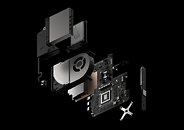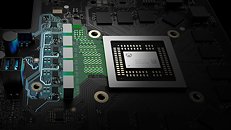Monday, June 12th 2017

Xbox One X Hardware Specs Give Gaming Desktops a Run for their Money
Microsoft Sunday dropped its mic with the most powerful game console on paper, the Xbox One X, formerly codenamed "Project Scorpio." The bottom-line of this console is that it enables 4K Ultra HD gaming at 60 Hz. Something like this requires you to spend at least $1,200 on a gaming desktop right now. Unlike a Windows 10 PC that's been put together by various pieces of hardware, the Xbox One X is built on a closed ecosystem that's tightly controlled by Microsoft, with heavily optimized software, and a lot of secret sauce the company won't talk about. The console still puts up some mighty impressive hardware specs on paper.
To begin with, at the heart of the Xbox One X is a semi-custom SoC Microsoft co-developed with AMD, built on TSMC's 16 nm FinFET node (the same one NVIDIA builds its "Pascal" GPUs on). This chip features a GPU with almost quadruple the single-precision floating point compute power as the one which drives the Xbox One. It features 40 Graphics CoreNext (GCN) compute units (2,560 stream processors) based on one of the later versions of GCN (likely "Polaris"). The GPU is clocked at 1172 MHz. The other big component of the SoC is an eight-core CPU based on an unnamed micro-architecture evolved from "Jaguar" rather than "Bulldozer" or even "Zen." The eight cores are arranged in two quad-core units of four cores, each; with 4 MB of L2 cache. The CPU is clocked at 2.30 GHz.The third major component of the Xbox One X SoC is the 384-bit wide GDDR5 memory controller, wired to 12 GB of memory. This memory is used both as system- and graphics-memory, and is the most ideal implementation of AMD's hUMA (heterogeneous unified memory architecture), where there's no visible partition between the system and graphics memory on the physical memory, and depending on the usage scenario, any amount of memory can be used by the CPU and GPU components. Developers are still forced to build their games under the assumption that the system only has 8 GB of memory; so that the remaining 4 GB is used as a kind of "guarantee" that 4K UHD @60 Hz runs smoothly. The total memory bandwidth available is a staggering 326 GB/s.
The SoC features an integrated audio CODEC with 7.1-channel output over HDMI, with support for Dolby Atmos, and HRTF, a new audio format Microsoft developed for the Hololens, which is optimized for VR.
A 1 TB 2.5-inch SATA hard drive comes standard on the Xbox One X. You can swap this drive out for larger HDDs, or faster SATA SSDs. You can also plug in external storage devices over the console's USB 3.0 ports. The console's operating system resides on a smaller eMMC chip that isn't accessible to end-users. The 1 TB HDD is used to store games you've downloaded from your online library à la Steam.
Microsoft switched from bulky external power bricks to internal PSUs with the Xbox One S, and the trend carries forward with the Xbox One X. Powering the whole thing is a 275W internal power-supply. A large fan-heatsink cools the SoC and GDDR5 memory chips.
Source:
Eurogamer.net
To begin with, at the heart of the Xbox One X is a semi-custom SoC Microsoft co-developed with AMD, built on TSMC's 16 nm FinFET node (the same one NVIDIA builds its "Pascal" GPUs on). This chip features a GPU with almost quadruple the single-precision floating point compute power as the one which drives the Xbox One. It features 40 Graphics CoreNext (GCN) compute units (2,560 stream processors) based on one of the later versions of GCN (likely "Polaris"). The GPU is clocked at 1172 MHz. The other big component of the SoC is an eight-core CPU based on an unnamed micro-architecture evolved from "Jaguar" rather than "Bulldozer" or even "Zen." The eight cores are arranged in two quad-core units of four cores, each; with 4 MB of L2 cache. The CPU is clocked at 2.30 GHz.The third major component of the Xbox One X SoC is the 384-bit wide GDDR5 memory controller, wired to 12 GB of memory. This memory is used both as system- and graphics-memory, and is the most ideal implementation of AMD's hUMA (heterogeneous unified memory architecture), where there's no visible partition between the system and graphics memory on the physical memory, and depending on the usage scenario, any amount of memory can be used by the CPU and GPU components. Developers are still forced to build their games under the assumption that the system only has 8 GB of memory; so that the remaining 4 GB is used as a kind of "guarantee" that 4K UHD @60 Hz runs smoothly. The total memory bandwidth available is a staggering 326 GB/s.
The SoC features an integrated audio CODEC with 7.1-channel output over HDMI, with support for Dolby Atmos, and HRTF, a new audio format Microsoft developed for the Hololens, which is optimized for VR.
A 1 TB 2.5-inch SATA hard drive comes standard on the Xbox One X. You can swap this drive out for larger HDDs, or faster SATA SSDs. You can also plug in external storage devices over the console's USB 3.0 ports. The console's operating system resides on a smaller eMMC chip that isn't accessible to end-users. The 1 TB HDD is used to store games you've downloaded from your online library à la Steam.
Microsoft switched from bulky external power bricks to internal PSUs with the Xbox One S, and the trend carries forward with the Xbox One X. Powering the whole thing is a 275W internal power-supply. A large fan-heatsink cools the SoC and GDDR5 memory chips.




132 Comments on Xbox One X Hardware Specs Give Gaming Desktops a Run for their Money
Its also highly possible that a custom Anti-Aliasing filter is applied in hardware and left up to the developer to make sure the code is utilizing the hardware for the differing edges and surfaces. AA usually is used at the expense of memory bandwidth, and where GDDR5 and on die caches are used along side hardware specific constraints I could easily see it rendering 4K 60FPS at 4XAF and 2 or 4XAA with minimal performance degradation as the bigger the texture size the less after effects magic massaging needs done since they are aiming this at a specific 4K screen size and not varying screen sizes.
Microsoft figured out how to get rendering a frame down to 16 CPU instructions so the CPU is mostly free to take care of other stuff.
Working hard to get promoted to Grand Wizzard in the PC Master Race, huh?
Remember, its Instructions PER Clock.